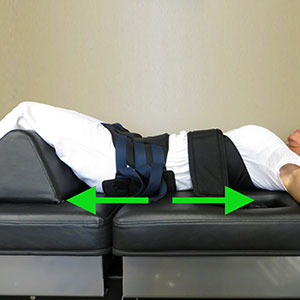Spinal Decompression Therapy
Every patient with Disc bulge, Disc herniation, Facet syndrome, and Cervical Spondylosis is not suitable for surgery due to multiple reasons. This is An FDA Cleared Non – Surgical, Non-Invasive, and Pain-Free Spinal Decompression Treatment.
Low Back Pain, Sciatica, and Cervical Pain are very common complaints among people from 18 – 60 years. According to a study, “It has been estimated that low back pain will affect approximately 80% of the population at some point during the life span.” Another study revealed that “The socioeconomic impact of low back pain, including both direct and indirect costs of health care and disability attendant to the disorder has been estimated to exceed $635 billion each year.”

According to a study Almost 70% of patients who go for an MRI Due to Low back pain are diagnosed with Disc Herniation, Disc bulge, or facet syndrome. Prevalence is huge and treatment choices are limited to Medicines, surgery, and alternative therapy
Low back pain is more prevalent. It’s the second most common reason to visit a doctor, the fifth most common reason for admission to a hospital, and the third most common indication for surgery. And, as the aging population grows, this number will predictably climb even higher. While low back and neck pain can typically be managed through traditional treatment options such as physical therapy, chiropractic care, or pain management, disco-genic pain can be more intractable. For many patients, addressing the underlying disc pathology is the only answer.
Low back pain is more prevalent. It’s the second most common reason to visit a doctor, the fifth most common reason for admission to a hospital, and the third most common indication for surgery. And, as the aging population grows, this number will predictably climb even higher. While low back and neck pain can typically be managed through traditional treatment options such as physical therapy, chiropractic care, or pain management, disco-genic pain can be more intractable. For many patients, addressing the underlying disc pathology is the only answer.
Reduction of Intra-discal pressure:
The aim of reducing intra-discal pressure is to enhance the osmotic diffusion of fluids and nutrients across the endplates into the disc, furthering the body’s natural healing abilities. Additionally, reduction of intra-discal pressures may help draw the nucleus pulposus of a herniated disc back into the center, thereby relieving pressure on a compressed nerve root—alleviating the problem and the pain.
Technology Designed to Overcome Reflex Contractions:
It is commonly recognized that achieving decompression depends upon the ability to distract the spine without eliciting reflex muscle contractions or spasms. Our equipment, RenuvaDisc monitors tension applied to the patient every 2.5 milliseconds and can make adjustments every 20 milliseconds. This ability to almost instantly sense and adjust tensions is a key difference that distinguishes RenuvaDisc Decompression from other devices and conventional traction.
20 Millisecond Response Time:
Use a system that fine-tunes forces almost instantly. RenuvaDisc’s computer-controlled biofeedback response adjusts distracting forces at an astounding rate of 20 milliseconds (the human neurological response is approximately 50 milliseconds). Old designs simply cannot react and adjust tensions at this incredible speed. While their load sensors and motors are designed to adjust forces in less than a second, the true reaction time is significantly longer as the force is disbursed and absorbed through the traction box, nylon webbing, pulleys, and harness systems.
The Significance of Bypassing Reflexes:
It is generally recognized that achieving decompression depends upon the ability to distract the spine without eliciting reflex muscle contractions or spasms. The Pre- and Post- MRI of a patient illustrate the dramatic physiological changes to the damaged disc— both a dramatic reduction in disc herniation and an increase in hydration, as observed through T-2 weighted imaging. These objective changes are not random occurrences in the incidence of disc pathology and suggest the dramatic reduction of intra-discal pressures and subsequent increase in the osmotic diffusion gradient across the disc endplates. Many patients, especially those presenting with acute disc pathology, experience a natural guarding reflex under traction. A recent meta-analysis evaluating conventional traction determined that “very few randomized controlled trials reported positive effects on low back pain, and increased pain and inter-vertebral pressures have been reported after its use. Additionally, conventional traction has never demonstrated the ability to reduce intra-discal pressures into the negative range.
Leading spine researchers Nachemsom and Anderson concluded that when traction is applied so that back muscles contract, then disc pressures will increase and patients get immense relief.
Leading spine researchers Nachemsom and Anderson concluded that when traction is applied so that back muscles contract, then disc pressures will increase and patients get immense relief.
Success Rate on VAS is 80-90%.
Our continuous monitoring system keeps registering treatment outcomes daily basis through the Visual Analog Scale (VAS). It registers PAIN RELIEF from 1-10. Most patients came with a 9-10 scale and after treatment, they showed significant relief and reported a 0-2 Scale improvement.
